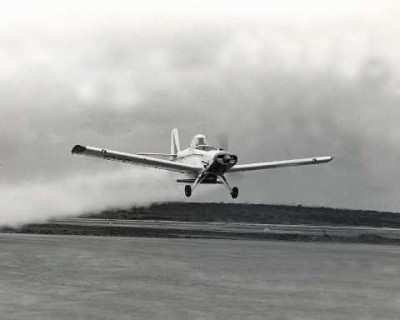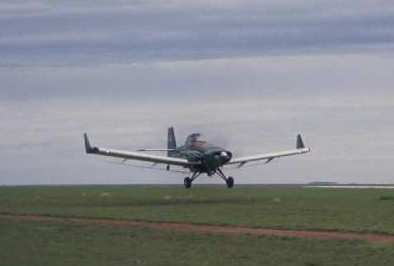Embraer Celebrates 40th Anniversary Of Crop Duster's First
Flight
Embraer is celebrating the 40th anniversary of the first flight
of the Ipanema crop duster, which took place on July 31st, 1970.
The airplane project began at the end of the 1960s, on the orders
of the Ministry of Agriculture, that the Research and Development
Institute (Instituto de Pesquisas e Desenvolvimento – IPD)
design the first agricultural aircraft to substitute imported
models. The project became a reality with the founding of Embraer,
in 1969. Today, the Ipanema is the leader of Brazil’s
agricultural aviation, with more than 1,100 planes delivered and
75% of the fleet in operation, nationwide.

Ipanema First Flight
The Ipanema was conceived to modernize Brazilian agriculture.
Initial studies began in 1969, and the name was chosen in honor of
the Ipanema farm, located in Iperó, 128 km (80 miles) far
from the city of São Paulo. At that time, this farm had a
school and an agricultural aviation research center maintained by
the Ministry of Agriculture.
 The first prototype of the Ipanema, registration number
PP-ZIP, was the second airplane produced by Embraer, soon after the
Urupema (EMB 400) glider. The original model (EMB 200) had a 260 HP
engine, fixed-pitch propeller, hydraulic spraying system, and a 580
liter hopper. The maiden flight took place on July 31, 1970, at
Embraer’s headquarters in São José dos Campos,
State of São Paulo, and approval was received in December
1971. The company Corsário de Aviação, from
the State of Goiás, ordered ten aircraft, in March 1971, and
was the Ipanema’s first customer. In February 1972, the first
airplane, registration number PT-GBA, was delivered and entered
service in the fight
The first prototype of the Ipanema, registration number
PP-ZIP, was the second airplane produced by Embraer, soon after the
Urupema (EMB 400) glider. The original model (EMB 200) had a 260 HP
engine, fixed-pitch propeller, hydraulic spraying system, and a 580
liter hopper. The maiden flight took place on July 31, 1970, at
Embraer’s headquarters in São José dos Campos,
State of São Paulo, and approval was received in December
1971. The company Corsário de Aviação, from
the State of Goiás, ordered ten aircraft, in March 1971, and
was the Ipanema’s first customer. In February 1972, the first
airplane, registration number PT-GBA, was delivered and entered
service in the fight
against pests that threatened cotton crops.
Sales of the Ipanema constantly grew, which significantly added
to Embraer’s own development. In November 1973, the 100th
airplane was delivered to Serviços Agro Aéreos do
Sul. In 1975, Uruguay’s Ministry of Agriculture and Fishing
ordered ten Ipanemas, along with five EMB 110 Bandeirantes, marking
Embraer’s first exports. In 1980, Embraer acquired
Indústria Aeronáutica Neiva, a company founded in
1954 and that produced small airplanes. With the merger of the two
companies, the Ipanema’s production was transferred to
Botucatu, São Paulo, in 1982, where it continues. In order
to adapt it to operational realities and to keep it in line with
the times, Embraer has made a number of modifications in the
Ipanema’s design, over the years, such as a variable pitch
propeller, larger wheels, more powerful 300 HP engine, tail wheel
with a larger diameter, new shock absorbers and wing profile, among
others.

First Ethanol-Powered Ipanema
The most recent and significant change, however, became a
reality in 2005. On March 15, the 1000th Ipanema was delivered.
Coincidentally, that was also the first model with the 320 HP
ethanol-powered engine, which is the same fuel developed in Brazil
used mainly by the nation’s automobiles. The project was
developed in a partnership with the Department of Aerospace Science
and Technology (Departamento de Ciência e Tecnologia
Aeroespacial – CTA). From that point on, Embraer began
to offer ethanol conversion kits for the airplanes powered by
aviation gasoline (AvGas). Currently, around 25% of the Brazilian
fleet uses ethanol.
FMI: www.embraer.com
 ANN's Daily Aero-Linx (04.30.25)
ANN's Daily Aero-Linx (04.30.25) ANN FAQ: Turn On Post Notifications
ANN FAQ: Turn On Post Notifications Classic Aero-TV: Agile Aeros Jeff Greason--Disruptive Aerospace Innovations
Classic Aero-TV: Agile Aeros Jeff Greason--Disruptive Aerospace Innovations Aero-News: Quote of the Day (04.30.25)
Aero-News: Quote of the Day (04.30.25) ANN's Daily Aero-Term (04.30.25): Expedite
ANN's Daily Aero-Term (04.30.25): Expedite





